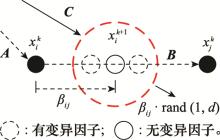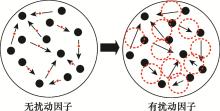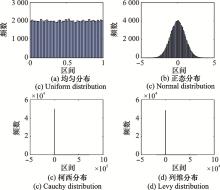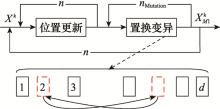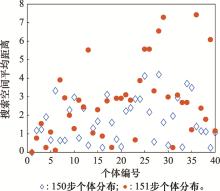Systems Engineering and Electronics ›› 2022, Vol. 44 ›› Issue (4): 1291-1300.doi: 10.12305/j.issn.1001-506X.2022.04.27
• Guidance, Navigation and Control • Previous Articles Next Articles
Improved firefly algorithm and its convergence analysis
Dali ZHANG1, Hongwei XIA1, Chaoxing ZHANG2, Guangcheng MA1, Changhong WANG1,*
- 1. School of Astronautics, Harbin Institute of Technology, Harbin 150001, China
2. Shanghai Aerospace Control Technology Institute, Shanghai 201109, China
-
Received:2021-12-07Online:2022-04-01Published:2022-04-01 -
Contact:Changhong WANG
CLC Number:
Cite this article
Dali ZHANG, Hongwei XIA, Chaoxing ZHANG, Guangcheng MA, Changhong WANG. Improved firefly algorithm and its convergence analysis[J]. Systems Engineering and Electronics, 2022, 44(4): 1291-1300.
share this article
Table 1
Benchmarks functions"
| 函数名 | 数学表达式 | 规模 | 最优值 |
| Sphere | ±100 | 0 | |
| Rosenbrock | ±30 | 0 | |
| Rastrigin | ±5.12 | 0 | |
| Griewank | ±600 | 0 |
Table 2
Four random disturbance factors simulation results"
| 扰动因子 | f1 | f2 | f3 | f4 | |||||||||||
| 最优值 | 时间/s | SR/% | 最优值 | 时间/s | SR/% | 最优值 | 时间/s | SR/% | 最优值 | 时间/s | SR/% | ||||
| GIFA | 2.301 3e-154 | 95.899 8 | 100 | 4.146 1e-09 | 82.201 | 0 | 0 | 15.544 3 | 10 | 0 | 24.261 5 | 10 | |||
| CIFA | 3.051 1e-109 | 41.303 4 | 100 | 0.001 065 2 | 46.112 3 | 0 | 60.357 1 | 17.461 3 | 0 | 0 | 24.782 4 | 50 | |||
| LIFA | 3.877 7e-105 | 534.637 7 | 100 | 1.060 1e-04 | 145.988 4 | 0 | 95.542 1 | 15.591 9 | 0 | 0 | 38.973 5 | 10 | |||
| RIFA | 0 | 25.457 8 | 100 | 1.384 9e-27 | 21.950 9 | 70 | 0 | 11.521 1 | 100 | 0 | 13.181 7 | 100 | |||
Table 3
Simulation results of fixed iterations"
| 算法 | f1 | f2 | f3 | f4 | |||||||||||
| 最优值 | 时间/s | SR/% | 最优值 | 时间/s | SR/% | 最优值 | 时间/s | SR/% | 最优值 | 时间/s | SR/% | ||||
| PSO | 1.455 7e-57 | 2.909 6 | 100 | 19.565 6 | 2.373 9 | 0 | 26.863 9 | 2.149 3 | 0 | 3.330 7e-16 | 2.647 6 | 23.3 | |||
| DE | 5.758 9e-29 | 2.696 9 | 100 | 24.598 4 | 2.799 9 | 0 | 23.737 9 | 2.290 8 | 0 | 0 | 3.038 3 | 70 | |||
| FA | 8.378 4e-88 | 14.653 8 | 100 | 0.007 324 5 | 8.805 5 | 0 | 21.838 7 | 1.185 | 0 | 0 | 3.024 9 | 90 | |||
| IFA | 0 | 25.457 8 | 100 | 2.258 8e-26 | 21.950 9 | 70 | 0 | 11.521 1 | 100 | 0 | 13.181 7 | 100 | |||
| 1 |
GHAREHCHOPOGH F S , GHOLIZADEH H . A comprehensive survey: whale optimization algorithm and its applications[J]. Swarm and Evolutionary Computation, 2019, 48, 1- 24.
doi: 10.1016/j.swevo.2019.03.004 |
| 2 | COLORNI A, DORIGO M, MANIEZZO V. Distributed optimization by ant colonies[C]//Proc. of the First European Confe-rence on Artificial Life, 1991: 134-142. |
| 3 | KENNEDY J, EBERHART R. Particle swarm optimization[C]//Proc. of the IEEE International Conference on Neural Networks, 1995: 1942-1948. |
| 4 |
KARABOGA D , BASTURK B . A powerful and efficient algorithm for numerical function optimization: artificial bee colony (ABC) algorithm[J]. Journal of Global Optimization, 2007, 39 (3): 459- 471.
doi: 10.1007/s10898-007-9149-x |
| 5 |
SAYADI M K , HAFEZALKOTOB A , NAINI S G J . Firefly-inspired algorithm for discrete optimization problems: an application to manufacturing cell formation[J]. Journal of Manufacturing Systems, 2013, 32 (1): 78- 84.
doi: 10.1016/j.jmsy.2012.06.004 |
| 6 | YANG X S . Nature-inspired metaheuristic algorithms[M]. Frome: Luniver Press, 2008. |
| 7 |
DARWISH S M . Combining firefly algorithm and Bayesian clas-sifier: new direction for automatic multilabel image annotation[J]. IET Image Processing, 2016, 10 (10): 763- 772.
doi: 10.1049/iet-ipr.2015.0492 |
| 8 | 张笑笑, 丁洁玉. 萤火虫算法求解多体系统动力学微分-代数方程[J]. 动力学与控制学报, 2021, 19 (2): 85- 90. |
| ZHANG X X , DING J Y . Firefly algorithm for multi-body system dynamics differential-algebraic equations[J]. Journal of Dynamics and Control, 2021, 19 (2): 85- 90. | |
| 9 | TRIPATHI S . A brief review of firefly algorithm: application in structural optimization problem[J]. Journal of the Institute of Engineering, 2020, 15 (2): 183- 191. |
| 10 |
BABBAR A , PRAKASH C , GUPTA M K , et al. Application of hybrid nature-inspired algorithm: single and bi-objective constrained optimization of magnetic abrasive finishing process parameters[J]. Journal of Materials Research and Technology, 2020, 9 (4): 7961- 7974.
doi: 10.1016/j.jmrt.2020.05.003 |
| 11 |
GANDOMI A H , YANG X S , TALATAHARI S , et al. Firefly algorithm with chaos[J]. Communications in Nonlinear Science and Numerical Simulation, 2013, 18 (1): 89- 98.
doi: 10.1016/j.cnsns.2012.06.009 |
| 12 | YU S H , YANG S L , SU S B . Self-adaptive step firefly algorithm[J]. Journal of Applied Mathematics, 2013, 832718. |
| 13 |
ALTAY E Y , ULUTA G . Self-adaptive step firefly algorithm based robust watermarking method in DWT-SVD domain[J]. Multimedia Tools and Applications, 2021, 80, 23457- 23484.
doi: 10.1007/s11042-020-10251-7 |
| 14 |
VERMA O P , AGGARWAL D , PATODI T . Opposition and dimensional based modified firefly algorithm[J]. Expert Systems with Applications, 2016, 44, 168- 176.
doi: 10.1016/j.eswa.2015.08.054 |
| 15 | MANJU A , NIGAM M J . An improved quantum inspired firefly algorithm with interpolation operator[J]. Advances in Intelligent Systems and Computing, 2014, 258, 69- 84. |
| 16 | 柳长源, 任宇艳, 毕晓君. 基于改进萤火虫算法的区域交通信号配时优化[J]. 控制与决策, 2020, 35 (12): 2829- 2834. |
| LIU C Y , REN Y Y , BI X J . Timing optimization of regional traffic signals based on improved firefly algorithm[J]. Control and Decision, 2020, 35 (12): 2829- 2834. | |
| 17 | 刘景森, 毛艺楠, 李煜. 具有振荡约束的自然选择萤火虫优化算法[J]. 控制与决策, 2020, 35 (10): 2363- 2371. |
| LIU J S , MAO Y N , LI Y . Natural selection firefly optimization algorithm with oscillation and constraint[J]. Control and Decision, 2020, 35 (10): 2363- 2371. | |
| 18 | WANG H , WANG W J , ZHOU X Y , et al. Firefly algorithm with neighborhood attraction[J]. Information Sciences, 2017, 382, 374- 387. |
| 19 | DHAL K G , DAS A , RAY S , et al. Randomly attracted rough firefly algorithm for histogram based fuzzy image clustering[J]. Knowledge-Based Systems, 2021, 216 (1): 106814. |
| 20 |
SHAN J , PAN J S , CHANG C K , et al. A distributed parallel firefly algorithm with communication strategies and its application for the control of variable pitch wind turbine[J]. ISA Transactions, 2021, 115, 79- 94.
doi: 10.1016/j.isatra.2021.01.026 |
| 21 | ELAKKIYA E, SELVAKUMAR S, VELUSAMY R L. CIFAS: community inspired firefly algorithm with fuzzy cross-entropy for feature selection in Twitter Spam detection[C]//Proc. of the 11th International Conference on Computing, Communication and Networking Technologies, 2020. |
| 22 |
ZHAO J , CHEN W P , XIAO R B , et al. Firefly algorithm with division of roles for complex optimal scheduling[J]. Frontiers of Information Technology and Electronic Engineering, 2021, 22 (10): 1311- 1333.
doi: 10.1631/FITEE.2000691 |
| 23 |
XING H X , WU H , CHEN Y , et al. A cooperative interfe-rence resource allocation method based on improved firefly algorithm[J]. Defence Technology, 2021, 17 (4): 1352- 1360.
doi: 10.1016/j.dt.2020.07.006 |
| 24 | 薛晗, 邵哲平, 潘家财, 等. 基于文化萤火虫算法-广义回归神经网络的船舶交通流量预测[J]. 上海交通大学学报, 2020, 54 (4): 421- 429. |
| XUE H , SHAO Z P , PAN J C , et al. Vessel traffic flow prediction based on CFA-GRNN algorithm[J]. Journal of Shanghai Jiaotong University, 2020, 54 (4): 421- 429. | |
| 25 |
GUPTA D K , SONI A K , JHA A V , et al. Hybrid gravitational-firefly algorithm-based load frequency control for hydrothermal two-area system[J]. Mathematics, 2021, 9 (7): 712.
doi: 10.3390/math9070712 |
| 26 |
CHENG Z W , SONG H H , CHANG T Z , et al. An improved mixed-coded hybrid firefly algorithm for the mixed-discrete SSCGR problem[J]. Expert Systems with Applications, 2022, 188, 116050.
doi: 10.1016/j.eswa.2021.116050 |
| 27 |
XUE X S , CHEN J F . Optimizing sensor ontology alignment through compact co-firefly algorithm[J]. Sensors, 2020, 20 (7): 2056.
doi: 10.3390/s20072056 |
| 28 |
WETS J B . Minimization by random search techniques[J]. Mathematics of Operations Research, 1981, 6 (1): 19- 30.
doi: 10.1287/moor.6.1.19 |
| 29 |
刘晓东, 孙丽君, 陈天飞. 布谷鸟算法的收敛性分析及性能比较[J]. 计算机科学与探索, 2020, 14 (10): 1644- 1655.
doi: 10.3778/j.issn.1673-9418.1912014 |
|
LIU X D , SUN L J , CHEN T F . Convergence analysis and performance comparison of cuckoo search algorithm[J]. Journal of Frontiers of Computer Science and Technology, 2020, 14 (10): 1644- 1655.
doi: 10.3778/j.issn.1673-9418.1912014 |
|
| 30 | JIAO B , LIAN Z G , GU X S . A dynamic inertia weight particle swarm optimization algorithm[J]. Chaos, Solitons & Fractals, 2008, 37 (3): 698- 705. |
| 31 | DAS S, KONAR A, CHAKRABORTY U K. Improved diffe-rential evolution algrithms for handling noisy optimization problems[C]//Proc. of the IEEE Congress on Evolutionary Computation, 2005: 1691-1698. |
| 32 | JOHNSON D S. Near-optimal bin packing algorithms[D]. Massachusetts: Massachusetts Institute of Technology, 1973. |
| [1] | Andi TANG, Tong HAN, Dengwu XU, Huan ZHOU, lei XIE. An improved salp swarm algorithm using Gaussian distribution estimation strategy [J]. Systems Engineering and Electronics, 2022, 44(7): 2229-2240. |
| [2] | Luyun QIU, Zhigeng FANG, Liangyan TAO, Qiucheng TAO. Effectiveness evaluation of network SoS based on improved FDNA model [J]. Systems Engineering and Electronics, 2022, 44(12): 3728-3737. |
| [3] | Lei LAI, Kun ZOU, Dewei WU, Baozhong LI. Multi-UAV cooperative path planning based on improved MOFA evolution of interactive strategy [J]. Systems Engineering and Electronics, 2021, 43(8): 2282-2289. |
| [4] | Yuqi CHEN, Tingxue XU, Jianping HAO, Cheng LU, Zhiqiang LI. Task capability dependency analysis of weapon system of systems based on FDN [J]. Systems Engineering and Electronics, 2021, 43(6): 1721-1728. |
| [5] | Lei LAI, Dewei WU, Kun ZOU, Kun HAN, Hailin LI. Three dimensional route planning of UAV based on the multi-criterion interactive membrane evolutionary algorithm [J]. Systems Engineering and Electronics, 2021, 43(1): 138-146. |
| [6] | Yan LI, Yunxiang CHEN, Chengkun LUO, Zhongyi CAI. Evaluation method for the supply capability of equipment support resources based on FA-ER [J]. Systems Engineering and Electronics, 2020, 42(3): 630-637. |
| [7] | FENG Yunwen, LIU Kuijian, XUE Xiaofeng, LIU Yuchang. Joint optimization of redundancy level and spare parts for redundant system based on Markov process [J]. Systems Engineering and Electronics, 2019, 41(4): 919-928. |
| [8] | SHI Yuedong, JIN Jiashan, XU Yifan. Multistate reliability analysis and assessment for complex technical system under semi-Markov processes [J]. Systems Engineering and Electronics, 2019, 41(2): 444-452. |
| [9] | FENG Xiao, GUO Linhan, SONG Changhao, KONG Dandan. Steady state availability modeling method for multicomponent equipment group based on CTMC family [J]. Systems Engineering and Electronics, 2018, 40(6): 1405-1410. |
| [10] | YIN Beibei, FANG Yunyu, NING Gaorong, WANG Bin. Asymmetric information countermeasure in networks and corresponding Nash strategy [J]. Systems Engineering and Electronics, 2017, 39(10): 2270-2277. |
| [11] | CUI Feng-zhe, WANG Xiu-kun, TENG Hong-fei. Dual-system cooperative co-evolutionary algorithm for non-separable function [J]. Systems Engineering and Electronics, 2016, 38(11): 2660-2669. |
| [12] | FAN Yang-tao, WANG Min-le, WEN Miao-miao, CHEN Da-lei. Analysis of ballistic missile penetration effectiveness based on FA-AHP [J]. Systems Engineering and Electronics, 2015, 37(4): 845-850. |
| [13] | LI Mu-dong, ZHAO Hui, WENG Xing-wei. Backtracking search optimization algorithm with comprehensive learning strategy [J]. Systems Engineering and Electronics, 2015, 37(4): 958-963. |
| [14] | YANG Xiao-long, TAN Xue-zhi. Estimation of primary user parameters in cognitive radio networks [J]. Systems Engineering and Electronics, 2015, 37(2): 406-411. |
| [15] | HOU Hong-tao,XIE Fei,ZHANG Wang-xun,WANG Wei-ping,HUANG Cong-shan. Availability analysis for constellation of GNSS based on Markov process [J]. Systems Engineering and Electronics, 2014, 36(4): 685-690. |
| Viewed | ||||||
|
Full text |
|
|||||
|
Abstract |
|
|||||
